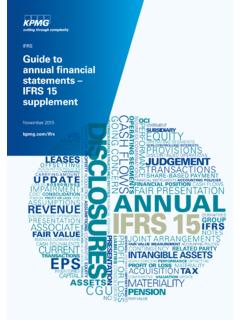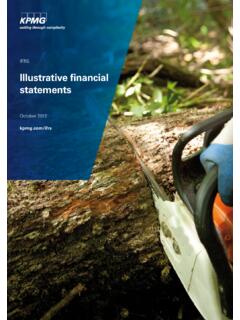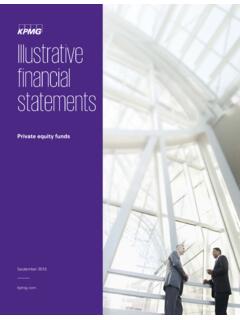Transcription of Disclosures under IFRS 9 - KPMG
1 2018 KPMG IFRG Limited, a UK company, limited by guarantee. All rights reserved. Disclosures under ifrs 9 February 2018 ifrs 9 Financial Instruments introduces extensive new disclosure requirements for classification and measurement, impairment of financial assets and hedge accounting. What s the aim?The objective of the disclosure requirements is for an entity to disclose information to enable users of financial statements to evaluate: the significance of financial instruments for the entity s financial position and performance; the nature and extent of risks arising from those financial instruments, both during the period and at the reporting date; and how the entity manages those s new?
2 Additional disclosure requirements arise principally in the following areas, all of which are highlighted in the following tables. Investments in equity instruments designated at fair value through other comprehensive income (FVOCI). Impairment, including:- credit risk management practices;- quantitative and qualitative information about amounts arising from expected credit losses (ECLs); and- credit risk exposure. Hedge organisations are impacted?The requirements apply to all entities but will be most significant for banks. The Disclosures for even the most simple corporates non-financial institutions will be will this publication help you?The tables do not provide a complete list of the disclosure requirements under ifrs 9.
3 Instead, they set out the principal changes to the disclosure requirements from those under ifrs 7 Financial Instruments: Disclosures under each of classification and measurement, impairment and separate section sets out the Disclosures that an entity is required to make on transition to ifrs under ifrs 9 | 1 2018 KPMG IFRG Limited, a UK company, limited by guarantee. All rights reserved. Classification and measurementDisclose the carrying amounts for: financial assets measured at fair value through profit or loss (FVTPL), distinguishing between those designated into that category and those mandatorily measured at FVTPL. financial liabilities measured at fair value through profit or loss (FVTPL), distinguishing between those designated into that category and those meeting the definition of held for trading.
4 Financial assets and, separately, financial liabilities measured at amortised cost; and financial assets measured at FVOCI, distinguishing between those mandatorily measured at FVOCI and investments in equity instruments designated as such on initial liabilities designated as at FVTPLIf an entity is required to present the effects of changes in that financial liability s credit risk in other comprehensive income (OCI), then disclose: any transfers of the cumulative gain or loss within equity during the period, including the reason for the transfer; and if the liability is derecognised during the period, then the amount (if any) presented in OCI that was realised at a detailed description of the methodologies used to determine whether presenting the effects of changes in a liability s credit risk in OCI would create or enlarge an accounting mismatch in profit or the effects of changes in a liability s credit risk are presented in profit or loss, then provide a detailed description of the economic relationship that it expects will result in the effects of changes in the liability s credit risk being offset in profit or loss by a change in the fair value of another financial instrument measured at in equity instruments designated as at FVOCID isclose.
5 Which investments in equity instruments have been designated as at FVOCI; the reasons for the designation; the fair value of each investment at the reporting date; dividends recognised during the period, separately for investments derecognised during the reporting period and those held at the reporting date; and any transfers of the cumulative gain or loss within equity during the period and the reason for those | Disclosures under ifrs 9 2018 KPMG IFRG Limited, a UK company, limited by guarantee. All rights reserved. If investments in equity instruments measured at FVOCI are derecognised during the reporting period, then disclose: the reasons for disposing of the investments; the fair value of the investments at the date of derecognition; and the cumulative gain or loss on of financial assetsFor all reclassifications of financial assets in the current or previous reporting period, disclose: the date of reclassification; a detailed explanation of the change in the business model and a qualitative description of its effect on the financial statements.
6 And the amount reclassified into and out of each that these Disclosures are required in the period of reclassification and the period following reclassifications from FVTPL to amortised cost or FVOCI, disclose: the effective interest rate (EIR) determined on the date of reclassification; and the interest revenue that these Disclosures are required for each period following reclassification until reclassifications from FVOCI to amortised cost, or from FVTPL to amortised cost or FVOCI, disclose: the fair value of the financial assets at the reporting date; and the fair value gain or loss that would have been recognised in profit or loss or OCI during the reporting period if the financial assets had not been disclosuresFor items of income and expense and gains or losses, provide: an analysis of the gain or loss recognised in the statement of profit or loss and OCI arising from the derecognition of financial assets measured at amortised cost, showing separately gains and losses arising from derecognition of those financial assets; and the reasons for derecognising those financial under ifrs 9 | 3 2018 KPMG IFRG Limited, a UK company, limited by guarantee.
7 All rights reserved. ImpairmentNew disclosure requirements apply about the credit risk of financial instruments (and contract assets in the scope of ifrs 15 Revenue from Contracts with Customers) to which ifrs 9 s impairment model is applied. These Disclosures should be sufficient for a user to understand the effect of credit risk on the amount, timing and uncertainty of future cash : Information about an entity s credit risk management practices and how they relate to the recognition and measurement of ECL including the methods, assumptions and information used to measure ECL. Quantitative and qualitative information to evaluate the amounts in the financial statements arising from ECL including changes and the reasons for those changes, in the amount of ECL.
8 Information about an entity s credit risk exposure including significant credit risk financial assets such as trade and lease receivables, and contract assets for which the loss allowance is always equal to lifetime ECL, reduced Disclosures examples are provided for the following Disclosures : a reconciliation of movements in loss allowances; an explanation of significant changes in gross carrying amounts; and information about credit risk exposures and risk management practicesExplain credit risk management practices and how they relate to the recognition and measurement of ECL such that a financial statement user can understand and evaluate: how the entity determines whether the credit risk of financial instruments has increased significantly since initial recognition, including whether and how:- financial instruments are considered to have low credit risk, including the classes of financial instruments to which the low credit risk exception has been applied.
9 And- the presumption that financial assets with contractual payments more than 30 days past due have a significant increase in credit risk has been rebutted; the entity s definitions of default for different financial instruments, including the reasons for selecting those definitions; how instruments are grouped if ECL are measured on a collective basis; how the entity determines that financial assets are credit-impaired; the entity s write-off policy, including the indicators that there is no reasonable expectation of recovery; and 4 | Disclosures under ifrs 9 2018 KPMG IFRG Limited, a UK company, limited by guarantee. All rights reserved. how the modification requirements have been applied, including how the entity:- determines whether the credit risk of a financial asset that has been modified while subject to a lifetime ECL allowance has improved to the extent that the loss allowance reverts to being measured at an amount equal to 12-month ECL; and- monitors the extent to which the loss allowance on those assets subsequently reverts to being measured at an amount equal to lifetime calculationsExplain the basis of the inputs, assumptions and the estimation techniques used when: estimating 12-month and lifetime ECL.
10 Determining whether the credit risk of financial instruments has increased significantly since initial recognition; and determining whether financial assets are also: how forward-looking information has been incorporated into the determination of ECL, including the use of macro-economic information; and changes in estimation techniques or significant assumptions made during the reporting period and the reasons for those arising from ECLP rovide a reconciliation for each class of financial instrument of the opening balance to the closing balance of the impairment loss reconciliation is given separately for loss allowances against financial assets and for provisions, unless presented together and shows the changes during the period for: instruments for which 12-month ECL are recognised; instruments for which lifetime ECL are recognised, separately for:- financial instruments that are not credit-impaired.












